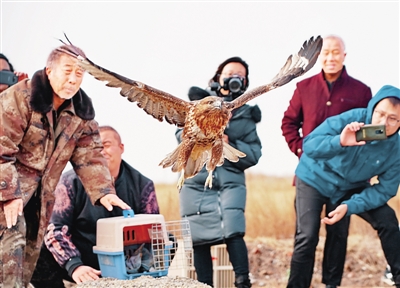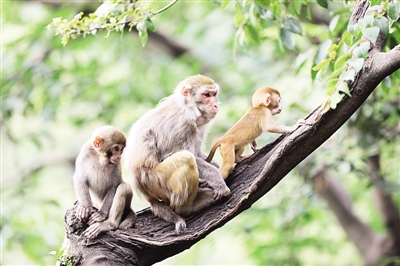How should humans and wild animals get along?
Author: Zhang Wenjuan (Senior Director of China Ecological Civilization Research and Promotion Association)
The severity and complexity of the COVID-19 epidemic far exceeded people’s expectations. Today, the host or intermediate host in novel coronavirus is considered to be related to wild animals such as bats or pangolins. Throughout the world’s major epidemics in human history, almost every time is related to wild animals, which further forces us to reflect: how do humans and wild animals coexist and coexist?

On November 16, 2019, at the Daqinghe Bird Rescue Station of Laoting County Wildlife Conservation Association in Hebei Province, the staff released an ordinary horseshoe crab. Xinhua news agency
Wild hosts of deadly viruses or bacteria.
The struggle between human beings and viruses or pathogenic bacteria has never stopped.
Plague is caused by a microorganism named Yersinia pestis. Besides mice, there are other common rodents and wild carnivores as the host animals. Besides these animals, there are fleas parasitic on them. The first recorded plague pandemic in human history occurred in the 6th century A.D., originated in the Middle East, and spread to North Africa and Europe through Egypt, killing nearly 100 million people. At that time, the total population of the world was only over 200 million. The second plague began in the mid-14th century, and in 300 years, the European continent lost 1/3 to 1/2 of its population. The third plague pandemic began in the second half of the 19th century, and it first broke out in Yunnan, China, and then broke out in South China, North China, Northeast China and other countries such as Europe, Asia and Africa.

Macaque Guangming Daily reporter living in Qianling Mountain Park, Guiyang City Xu Tanshe/Guangming Picture
In 1976, a terrible disease broke out in Sudan and Zaire in West Africa, and the patient died quickly after high fever and systemic bleeding. Scientists found a new virus in the body of the deceased and named it after Ebola, a beautiful river in West Africa. This is a typical zoonotic infectious disease, and mammals such as humans, apes, porcupines, antelopes, monkeys and fruit bats may be infected. Scientific research suggests that fruit bats may be the natural reservoir of Ebola virus.
Marburg virus is a close relative of Ebola virus. The virus first appeared in Germany in 1967, 31 people were infected and 7 people died. The source of infection was traced back to a group of African green monkeys from Uganda. The largest Marburg virus epidemic on record occurred in Angola, Africa in 2005, when the mortality rate was as high as 90%. At present, there are 12 outbreaks of Marburg virus, the most recent of which was in Uganda in 2017.
SARS, a disaster that is still fresh in our memory, has a mortality rate of 11%. SARS coronavirus is the same as novel coronavirus coronavirus. At first, some people thought civet cats were the host of the virus, but after more than ten years of follow-up research, scientists detected the gene residue of SARS virus in the body of Jutoubat, and thought that Jutoubat might be the real culprit of SARS virus.
For thousands of years, as the oldest enemy of human beings, viruses have been coexisting with human beings. Viruses are always threatening human beings, and human beings are constantly developing medicine to conquer viruses. Nowadays, plague has become less attractive, mainly due to the advent of plague vaccine in 1908 and the development of modern biomedicine. However, new viruses are still emerging one after another, and some old viruses are also making a comeback in a mutated way. We have to be on our guard at all times.
Pandora’s Box was opened.
The deadly virus or bacteria infected by human beings are actually permanent residents of other species. For example, bats carry a variety of viruses, including hundreds of coronaviruses; Wild snakes carry a variety of parasites in the body. If humans are infected, they can cause peritonitis, septicemia, pericarditis, iriditis and other diseases. In severe cases, they will damage many organs and even endanger their lives. Raccoon is the natural host of rabies virus, and many parasites carried in it can cause damage to human intestines and stomach. The wild groundhog, which became popular on the Internet because of the "expression pack", also carries Yersinia pestis and other germs that can cause intestinal, liver and brain damage.
Generally speaking, without human intervention, these viruses or bacteria only exist in wild animals. One of the unique qualities of bats is that they are more tolerant of viruses than other mammals. As the only mammal that can fly, bats have a special immune system. In this regard, there is a popular expression on the Internet: "Bats have a high fever of 40 degrees for a long time, and they have sealed the virus for thousands of years by themselves, staying up all night and trying to play a lonely Pandora’s box, so that the virus can coexist peacefully with itself."
However, as human beings at the top of the biological chain, they sometimes do the opposite, attacking and hunting wild animals for their own selfish desires, and causing many innocent creatures to suffer.
In some people’s eyes, bats, mice, snakes, pangolins, monkeys and other wild animals are all edible and delicious. Wild animals such as Chinese sturgeon, civet cats and pangolins are on the verge of extinction in many areas due to human overfishing and eating. The populations of giant salamander (giant salamander), wild sea cucumber, wild frogs, wild birds, muntjac, musk deer, gecko and other species have declined sharply.
Human’s aggression against animals is not only manifested as appetite. In the documentary "The Secret of the Billionaire’s Wardrobe", there is a pair of shoes, only ten pairs are sold worldwide, and the valuation is 20,000 US dollars. The special feature of this pair of shoes is that they are made from the skins of nine kinds of animals, except ostrich skin, crocodile skin, snake skin, and even lizard skin and elephant skin. Luxury brand Hermes has a white platinum bag of Himalayan crocodile, and its flawless leather is actually peeled off from the crocodile.
In addition, in the process of rapid industrialization and urbanization, forests are cut down, wetlands are squeezed out, and the habitats of wild animals are artificially occupied and separated … … Human activities increase the probability and speed of viruses or pathogenic bacteria in wild animals spreading to human bodies, especially in cities with high population density, which are more prone to epidemic diseases.
It can be seen that we humans have crossed the border of peaceful coexistence with wild animals, destroyed the original balance of nature, and opened the Pandora’s Box for the spread of epidemics, so that viruses or pathogenic bacteria that originally lived in a closed loop can invade the human body, and constantly mutate and recombine, weaving new strains of viruses or bacteria with stronger toxicity and tolerance, which will inevitably give human beings a painful lesson.
不打扰,就是最好的相处方式
人类和自然界的关系比我们想象的要复杂得多。任何野生动物,无论是濒危的还是常见的,在生态系统中都有独特的功能和定位,其他物种无法取代。因此,要从源头上预防新发传染病,我们能做的,就是不打扰——这也是人类与野生动物相处的最好方式。
不打扰的前提,是我们必须学会敬畏自然。中华文明历来强调“天人合一”的自然观,道家崇尚“道法自然”“清静无为”,孔子提倡“钓而不网,弋不射宿”。如今,我国的经济社会发展进入到一个全新的历史阶段,随着习近平生态文明思想的形成、发展与成功实践,我们必须承认自然的主体价值,敬畏自然,敬畏生命。
不打扰的内涵,是我们必须学会和谐共生。杜绝不合理的野生动物消费只是最基本的要求,同时还要减少、杜绝对野生动物栖息地的侵扰。在很多人看来,山里没有了野生动物,山还是原来的山。而从生态学的角度看,没有了野生动物,山已经不是原来的山了。一些野生动物的相继灭绝,意味着地球生态系统被破坏,随后,各种自然灾害就会接踵而来。
The principle of not disturbing is to keep a scientific and reasonable distance. Just when novel coronavirus was raging, wildlife management stations in some places drove away wintering bats on a large scale; In some places, the dogs in the whole village have been killed, and the number of stray cats and dogs in the city has increased in an instant … … It is our human fault to simply and rudely transfer the blame to other animals. From a painful experience, we should think deeply: what kind of distance should we keep between human beings and wild animals? Wild animals grow freely in their own territory. If it is not human intrusion, how can viruses or pathogenic bacteria invade and endanger human health and even life?
The root of not disturbing is to establish a correct value concept. With the continuous expansion of human greed and the increasing ability to capture nature, when what is claimed exceeds the output of nature, the ecological balance will be broken and human beings will face the crisis of losing their survival safety. The rapid development of industrial civilization for hundreds of years has degraded the earth’s biosphere to the brink of collapse. We must establish correct values, take the idea of ecological civilization as the guide, accelerate the formation of green production methods and lifestyles, consciously protect wild animals, maintain ecological balance, and realize friendly symbiosis and harmonious coexistence between human beings and wild animals.